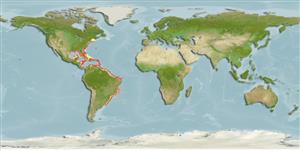Environment: milieu / climate zone / depth range / distribution range
Écologie
marin bathydémersal; profondeur 87 - 544 m (Ref. 37343), usually 300 - 500 m (Ref. 9626). Deep-water; 46°N - 37°S, 97°W - 32°W (Ref. 57286)
Western Atlantic: Canada (Ref. 5951) North Carolina, the Gulf of Mexico, Caribbean Sea to Uruguay (Ref. 47377) and Brazil (ISH specimens).
Taille / Poids / Âge
Maturity: Lm ? range ? - ? cm
Max length : 14.4 cm TL mâle / non sexé; (Ref. 49695); common length : 10.1 cm SL mâle / non sexé; (Ref. 13608)
Épines dorsales (Total): 10; Rayons mous dorsaux (Total): 9; Épines anales 2; Rayons mous anaux: 7 - 8; Vertèbres: 25. Anterior edges of pelvic spine, and 2nd spines of 1st dorsal and of anal fin serrated, but that of 2nd dorsal smooth (Ref. 13608).
Inhabits outer parts of the continental shelves and the upper parts of these slopes (Ref. 37343).
Life cycle and mating behavior
Maturité | Reproduction | Frai | Œufs | Fécondité | Larves
Schwarzhans, W.W. and A.M. Prokofiev, 2017. Reappraisal of Synagrops, Günther, 1887 with rehabilitation and revision of Parascombrops Alcock, 1889 including description of seven new species and two new genera (Perciformes: Acropomatidae). Zootaxa 4260(1):1-74. (Ref. 116586)
Statut dans la liste rouge de l'IUCN (Ref. 130435)
Menace pour l'homme
Harmless
Utilisations par l'homme
Plus d'informations
RéférencesAquacultureProfil d'aquacultureSouchesGénétiqueElectrophoresesHéritabilitéPathologiesTraitementNutrientsMass conversion
CollaborateursImagesStamps, Coins Misc.SonsCiguateraVitesseType de nageSurface branchialeOtolithesCerveauxVision
Outils
Articles particuliers
Télécharger en XML
Sources Internet
Estimates based on models
Preferred temperature (Ref.
123201): 8.6 - 16.9, mean 11.6 °C (based on 109 cells).
Phylogenetic diversity index (Ref.
82804): PD
50 = 0.5001 [Uniqueness, from 0.5 = low to 2.0 = high].
Bayesian length-weight: a=0.00871 (0.00509 - 0.01490), b=2.98 (2.83 - 3.13), in cm total length, based on LWR estimates for this species & (Sub)family-body (Ref.
93245).
Niveau trophique (Ref.
69278): 3.5 ±0.5 se; based on size and trophs of closest relatives
Résilience (Ref.
120179): Milieu, temps minimum de doublement de population : 1,4 à 4,4 années (Assuming tmax>3).
Fishing Vulnerability (Ref.
59153): Low vulnerability (10 of 100).
